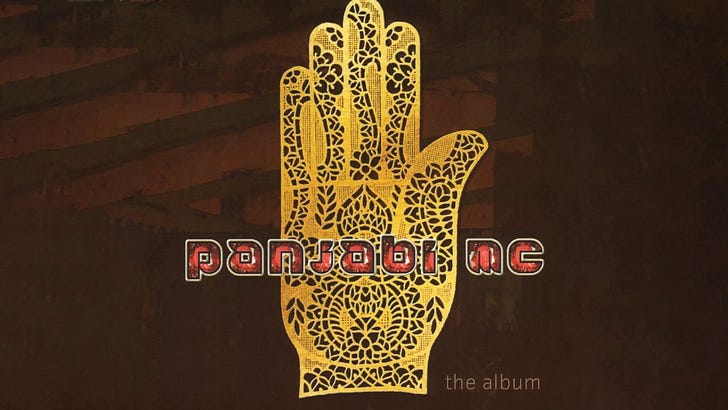key: Eb phrygian?
mode: Eb Fb Gb Ab Bb Cb Db
melody: tumbi — Db Eb Fb F; voice — Cb Db Eb Fb Gb Ab; Knight Rider dulcimer riff — G Ab A/Bbb Bb Cb
form: verse-chorus
meter: duple
English function names: tonic subtonic
Tagg (modified): home counterpoise (away)
Riemann: T ???
Scale degrees: i vii
Chords: Ebm Dbmverse:
Ebm
|:/ / / / :|9x
chorus:
Ebm Dbm
|:/ / / / |/ / / / |/ / / / |/ / / / :|I had many initial thoughts about this song that transformed into quite different thoughts as I researched the background and went through the process of transcribing it. I'm human and form lots of opinions based on superficial interactions with the world, which is to say, that I heard this song at some point in the recent past, noticed the bass line, and put it in my list of potential two-chord songs to check out later. Later is now.
I assumed that because it used the Knight Rider sample that it was also going to be phrygian-dominant. Nope! I am somewhat reluctant to put up a pitch set for the melody because the whole tuning system is not the same as what we use here in the Western world. I definitely left out the solfége and would consider using sargam, if I knew that system. You can hear the tuning differences in the tumbi part, but also in the vocals.
The tumbi part already implies a different pitch set — or at least a different way of thinking about the pitch set — because of the F natural, which sounds flat to my ears,1 but I definitely parse as F natural and not F-flat. Because it opens the whole song by itself, it sets up a norm that we are simply not dealing with solely Western stuff here. By the end of the intro, you hear that there's both this flat F and F-flat. It's clear that both of these pitches belong — they are "diatonic" to this song. Unlike the non-diatonic tones in the dulcimer patch from Knight Rider, which are more clearly ornamental.
If this scale is considered "exotic" in Western settings, what happens when it comes back to one of those "exotic" locations via Western popular music?2 Is it even perceived in this song by Indian ears as one of the ragas or is it perceived as a Western thing? Do people write about such things in India? In English? Is it just something we white folk wring our hands about? I would love to know more about such things. Then I realize this was a "hit" only in Europe. Panjabi MC is British (of Indian descent), but his vocalist Labh Janjua was Punjabi. What would the vocalist have said about what pitch set he used and why? What traditions was he steeped in?
Music pedagogy obviously is shaped by the traditions one is in. And most certainly pedagogy exists outside of schools, it's just not formalized or discussed inside of schools. I am curious about how people learn to perceive and think about musical phenomena in informal contexts. I am curious what Labh Janjua's training is, as a Bollywood singer. Who are the Edwin Gordons and Lucy Greens the Philip Taggs & Bob Claridas of non-Western musical styles? Would I understand what they are talking about?3
Can we even call this phrygian? What do we harmonize this with? Could we? Definitely take the above progressions with a grain of salt. Should we? I mean, the chorus is harmonized. And sure, the verses are too, but not in a Western way. We are looking at something that is already a hybridization of styles and values, the results of living in the modern world. And the answer is of course: Yes! And no! The answer is no if we are trying to respect it as it is and learn to play it as it is. The answer is yes if we want to use this as a springboard into something else, which is absolutely how culture works. From a pedagogical standpoint, we need to do both respect is as it is and use it as a springboard into our own developing viewpoints and values, which are in constant flux, whether we like it or not. Taking on both perspectives is how we grow as musicians and hopefully as people, too.
Flex-band arrangements courtesy of me & Sheet Music Direct: Complete set, all transpositions C instruments (incl. viola) Bb instruments Eb instruments F instruments bass clef instruments
I definitely want to avoid the term “microtonal,” which I feel only makes sense applied to modern Western Classical compositions that use pitches between 12-tone equal or well temperaments.
I mean, it's not like the scale left and was forgotten, but the harmonies in the chorus are sampled from a Western popular music song.
I've talked about Edwin Gordon frequently in other posts. Lucy Green has several books about informal learning processes in music and how they might be incorporated — allowed to happen, I suppose — in more formal settings. Philip Tagg, I've mentioned often, but he and Bob Clarida have a fascinating book describing how they devised a way to figure what semiotic meanings people generally associate with musical phenomena. I will write in the following post how I attempted to recreate that process with my HS students.



